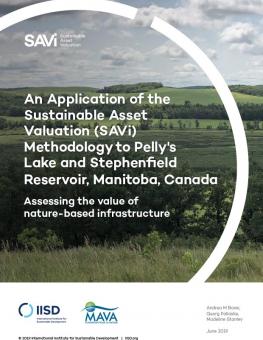
An Application of the Sustainable Asset Valuation (SAVi) Methodology to Pelly's Lake and Stephenfield Reservoir, Manitoba, Canada
This report provides a valuation of the ecosystem services in Stephenfield Reservoir and Pelly's Lake in Manitoba, Canada.
In Manitoba, Canada, and indeed all over the world, policy-makers grapple with the costs of maintaining natural ecosystems, including wetlands, forests, protected areas, etc.
As public budgets diminish, decision makers are often viewing such spending as a luxury that can be ill afforded, especially in light of other seemingly more urgent upgrades in mobility, healthcare, education, transport, social housing and the like.
However, natural ecosystems provide a range of “services”—that is, ecosystem services—such as storing water, supplying water, protecting against floods, preventing erosion, reducing the impacts of heat and drought, reducing air pollution, reducing noise pollution and improving aesthetics. With the advent of climate change, natural ecosystems are also critical, as they serve as buffers against catastrophic weather and the resulting floods, droughts, landslides and forest fires.
However, what is the financial value of these “services”? Also, if policy-makers, investors and citizens were better informed on these services and their values, would it support the conservation and regeneration of natural habitats? Alternatively, to put it another way, would citizens, businesses, industries, investors and governments be ready to spend on maintaining natural ecosystems if there were more predictability and certainty about the services natural ecosystems can provide?
This SAVi assessment responds to these questions. It gives a valuation of the ecosystem services provided by examples of built and natural infrastructure: (i) Stephenfield Reservoir is a civil engineered reservoir that was built for irrigation and domestic water supply; and (2) Pelly’s Lake is a natural wetland that is being actively managed for flood control.
Their added benefits are related to improved habitat and biodiversity, groundwater recharge, nutrient and sediment sequestration, carbon offsets and various economic uses of the biomass (plant material). From there, the assessment values the cost of the grey infrastructure that would be needed to provide the same level of service.
You might also be interested in
A Sustainable Asset Valuation of Non-Motorized Transport in Coimbatore, India
A Sustainable Asset Valuation (SAVi) of the economic, social, and environmental benefits of a non-motorized transport (NMT) network in Coimbatore, India.
Sustainable Asset Valuation of the Kalivaç and Poçem Hydropower Projects
The SAVi results suggest that the hydropower assets cannot be considered a preferable solution to generate electricity for the Albanian people.
Sustainable Asset Valuation (SAVi) of Senegal’s Saloum Delta
The assessment provides an economic valuation of the contribution of the Saloum Delta to local livelihoods and regional development.
An Application of the Sustainable Asset Valuation (SAVi) Methodology: Assessing the economic value of restoring the wetlands of S'Ena Arrubia and Corru S'Ittiri-Marceddì-San Giovanni in the Gulf of Oristano in Sardinia, Italy
This assessment uses the Sustainable Asset Valuation (SAVi) tool to calculate the economic and societal value generated by the S’Ena Arrubia and Corru S’Ittiri-Marceddì-San Giovanni wetlands in the Gulf of Oristano in Sardinia, Italy.